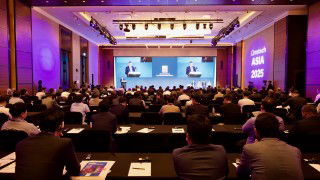Russia’s cement market is enjoying significant levels of growth and supplied an ideal backdrop to BusinessCem’s 23rd International Conference and Exhibition, which took place at the President Hotel in Moscow, Russia, between 22-25 April 2013.

Representatives from the ministries of Regional Development of the Russian Federation and of Construction
in the Moscow region joined the organisers in welcoming the guests to BusinessCem Moscow
As you negotiate the busy Moscow traffic, you can’t escape the Russian capital’s architectural diversity: picturesque and colourfully-painted late-medieval churches with domed roofs, the elegant pre-Revolution houses, the stark, angular Soviet-era official buildings and the modern glass skyscrapers exuding a newly-found confidence. The construction industry has clearly been very active throughout the centuries, changing the face of Moscow as Russia wrote history. The presence of building sites and cranes in today’s city also reveals the industry’s continued activity going forward, providing a sound bedrock for cement market growth. Last year, cement producers enjoyed a particularly good year as domestic cement demand hit a record 65.2Mta and at 61.5Mta, their output is the highest since 1993. While imports also reached record levels, Russia’s cement producers have been unperturbed in renewing their production base and raising capacity utilisation rates.
Against this backdrop, the organisers reported the attendance of some 220 delegates to the latest edition of BusinessCem’s annual Russian conference, which officially opened on Tuesday, 23 April 2013. Representatives from the Russian Department of Industry and Infrastructure, the Ministries of Regional Development of the Russian Federation and of Construction in the Moscow region joined the National Association in welcoming the guests and prepared the ground by outlining the construction panorama in the country. The first word on behalf of the cement industry was given to Mikhail Skorokhod, president of ZAO Eurocement Group, Russia’s largest cement producer.

Conference papers provided for plenty
of discussion points for the coffee breaks
His keynote address was followed by a presentation by the Ukrainian cement association Ukr Cement as Sergey Mozgovoy gave his summary of the Ukrainian cement industry. Returning back to Russia, CMPro’s Vladimir Gouz reviewed 2012 as “quite a successful year” as well as highlighting long-term trends in the country’s cement industry. A Ryjikov, president of the Moscow Stock Exchange gave delegates an insight into the profile of cement companies listed on the exchange. Portland cement represents around 5-6 per cent of the exchange’s trade. Mr A Batushansky of Decision Group brought the conversation back to the construction industry.
Technical offering
The first technical presentation of the event came from Mr E Tschegolyayev, KHD Humboldt Engineering (Russia) regarding the company’s involvement in the new cement line at YuGPK’s Novotroitsk works. Mr Velten of Germany’s Aumund presented his company’s technologies for handling and storage, followed by conference sponsor Haver & Boecker’s Alexander Heinrich, who delivered a presentation outlining the required expenditure for the construction and organisation of a new cement packing plant. Mr P Pokluda of PSP Engineering (Czech Republic) and Mr P Boiger of Mertec Switzerland highlighted the issues of cement mill reconstruction and gear units for cement and minerals, respectively.
Mr K Eichas of Germany’s VDZ highlighted the importance of increased use of blast furnace slag as a strategy to reduce primary energy consumption and CO2 emissions.
The afternoon gave time to further technical presentations. Mr I Zlobin of Loesche, Germany, outlined the features of cement grinding technology in Loesche vertical mills and Mr P Laube of A TEC (Poland) offered the audience information about the optimisation and modernisation of cement plants before the subject moved firmly to the pyroprocessing phase of cement production. Here, Mr V Berezovsky of A TEC Greco (Belarus) extolled the virtues of high-momentum kiln burners, while Mr A Spitsin of Hoganas Bjuf (Sweden) and Mr D Chavis of Bricking Solutions presented refractory solutions. After the contact break, further presentations followed by Ms A Troshina – Sventa AG (Switzerland), Mr S Dzyuba of JSC Beumer (Russia) and Mr D Pitesa of Italy’s Forgiatura A Vienna.
The latest grinding developments were highlighted by Mr V Zerr of Gebr Pfeiffer and Mr N Schetinin of Christian Pfeiffer while Ms I Ostmann of Muhlen Sohn showcased Fluitex airslide fabrics – all bringing German technology to the Russian market.

Delegates were able to complement to conference
programme by attending the accompanying exhibition
and network in a relaxed atmosphere
The following day Koki Ikeda of Kawasaki (Japan) kicked off the day’s proceedings by explaining his firm’s denitration technology for the cement plant. Mr M Pankevich of JSC Wirtgen offered insights into the benefits of the Wirtgen Surface Miner in the cement industry, avoiding the need for costly blasting operations. For those interested in distribution and terminals, IBAU Hamburg’s Mr D Weiss who gave his presentation “Modern storage and distributing terminals as practical application of IBAU Hamburg engineering support and technologies’’. Outlining the firm’s experience in Russia with the implementation of clinker cooler technology, Frank Lichomski of IKN GmbH (Germany) preceded Mr I Moiseev of JSC INTREY Chemistry Production’s presentation regarding Densit technology. The late morning saw further refractory technology with Mr V Korneev of JSC RHI Vostok’s take on the ANKRAL Q series and Magnesita Europe’s Mr D Schmidel’s advice on the selection of refractory materials. Mr D Rezyapov of JSC Brokk rounded off the morning’s proceedings with his presentation “Dismantling machine Brokk in the cement industry”.
The final presentation of the conference was given by Mr V Kulabuhov of JSC NIICement who led the extensive line-up of presentations to a fitting end as he discussed new technologies for the cement industry. After time for discussion, BusinessCem’s organisers brought the 23rd Conference and Exhibition to a close and allowed guests to prepare for the final gala dinner.
Exhibition
The conference was complemented by a 21-stand exhibition which featured equipment suppliers from across the world including Loesche, Gebr Pfeiffer, Vakoma, Kawasaki, FLSmidth MAAG Gear, Haver & Boecker, Höganäs Bjuf, Thyssenkrupp Polysius, Bedeschi and Christian Pfeiffer.
Article first published in International Cement Review, June 2013.
